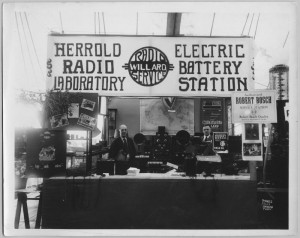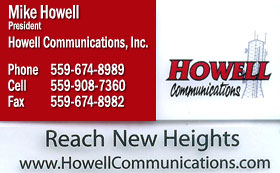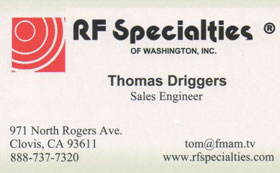Charles David Herrold
The story of a Father to Broadcasting
It’s 1909, more than 10 years before Westinghouse and Frank Conrad would broadcast US presidential election returns on KDKA. . .
 At the Herrold College of Engineering and Wireless located in the seven-story Garden City Bank Building in San Jose, an interesting thing is happening. Dr. David Herrold, head of the college, and one of his students, 16-year-old Ray Newby, have connected a carbon microphone in series with the B+ high voltage supply to a 15 watt spark gap transmitter. A cable runs from the transmitter to the top of the bank building, where an experimental antenna consisting of over 11,500 feet of bronze wire stretches like an umbrella over the roof to three smaller buildings along side. Dr. Herrold and his student fire up the device and speak into the microphone. Local amateur radio operators, who are listening to the dots and dashes of Morse code, are surprised to hear voices in their headphones. They soon contact the College to let Dr. Herrold know his 50-watt radio transmissions are being heard. Herrold College of Wireless and Engineering students spend time building simple crystal radio receivers for listeners to pick up their transmissions. Unfortunately, radio transmissions had to remain short, as the carbon element in the microphone could only last but a few hours before burning out. Herrold tired of the raspy sound of his spark transmitter began experimenting with other methods of voice transmission. Herrold noticed that the arc-type street lamps used at the time would emit a humming sound created by the oscillations of the arc. Herrold and his students discovered that enclosing multiple lamps in a tube of distilled water quenched the arc and made it vibrate at a higher frequency. With the higher frequency created, Herrold put a microphone into the circuit. Unfortunately, the carbon granules would get hot and burn up in short order. Herrold created a new, larger five element water-cooled microphone to hold the temperature down. This new transmitter he called the “Arc Fone”. The 500 volts needed to run this transmitter was tapped from the San Jose streetcar lines. The Arc Fone was patented on December 21, 1915.
At the Herrold College of Engineering and Wireless located in the seven-story Garden City Bank Building in San Jose, an interesting thing is happening. Dr. David Herrold, head of the college, and one of his students, 16-year-old Ray Newby, have connected a carbon microphone in series with the B+ high voltage supply to a 15 watt spark gap transmitter. A cable runs from the transmitter to the top of the bank building, where an experimental antenna consisting of over 11,500 feet of bronze wire stretches like an umbrella over the roof to three smaller buildings along side. Dr. Herrold and his student fire up the device and speak into the microphone. Local amateur radio operators, who are listening to the dots and dashes of Morse code, are surprised to hear voices in their headphones. They soon contact the College to let Dr. Herrold know his 50-watt radio transmissions are being heard. Herrold College of Wireless and Engineering students spend time building simple crystal radio receivers for listeners to pick up their transmissions. Unfortunately, radio transmissions had to remain short, as the carbon element in the microphone could only last but a few hours before burning out. Herrold tired of the raspy sound of his spark transmitter began experimenting with other methods of voice transmission. Herrold noticed that the arc-type street lamps used at the time would emit a humming sound created by the oscillations of the arc. Herrold and his students discovered that enclosing multiple lamps in a tube of distilled water quenched the arc and made it vibrate at a higher frequency. With the higher frequency created, Herrold put a microphone into the circuit. Unfortunately, the carbon granules would get hot and burn up in short order. Herrold created a new, larger five element water-cooled microphone to hold the temperature down. This new transmitter he called the “Arc Fone”. The 500 volts needed to run this transmitter was tapped from the San Jose streetcar lines. The Arc Fone was patented on December 21, 1915.
Herrold became the first broadcaster to play music across airwaves on a regular basis placing his water-cooled microphone in front of a phonograph. He read news reports from the local paper. At the beginning of a broadcast, since call letters were not being issued yet, listeners would hear, “This is the Herrold Station” or “San Jose calling”. The early listeners heard programs that would publicized the College. Herrold created listening room with chairs and 24 sets of receivers at a local furniture store. Later, in 1912 he would set up another transmitter at the Fairmont Hotel in San Francisco, becoming a pioneer “two way” broadcaster. One of the stations first on air programs was broadcast by Herrold’s wife Sybil. Every Wednesday at 9PM, Sybil hosted the ‘Little Ham Program’, playing records for children provided by the Sherman Clay music store—perhaps the first radio trade-out! Local record sales increased as listeners would go to the record store the day after the broadcast to buy the song they had heard on the radio the night before.
The Wireless Act of 1912 required licenses for the first time. Regulations required some form of call letter identification for all stations, although the station could choose its own. Herrold chose ‘FN’, backwards for National Fone, referring to the National Wireless Telephone and Telegraph Company. Other call letters assigned to Herrold were 6XE (portable) , 6XF and SJN. The Fairmont Hotel station was 6XG. The SJN call was used until 1921 when the government decreed all stations were to have a new ‘limited commercial’ license. In addition, all stations were to share time on a single frequency, 360 meters. Unfortunately Herrold’s Arc Fone system did not work well under wavelengths under 600 meters and he was forced to construct a tube-type transmitter a great expense to stay on the air. The station was issued the new call of KQW, which it held until 1949 when the station was purchased by CBS and the call change to KCBS. Due to financial difficulties with the Arc Fone and unable to handle the College’s finances, Dr. Herrold sold KQW to the First Baptist Church in San Jose in 1925. Herrold stayed on with KQW as station engineer for a few years, until the station was sold again. Later Herrold hosted children’s programs on KTAB and KFWM in Oakland. The man who some believe was the real ‘Father of Broadcasting’ died in obscurity in a Hayward rest home at 73 on July 1, 1948.


